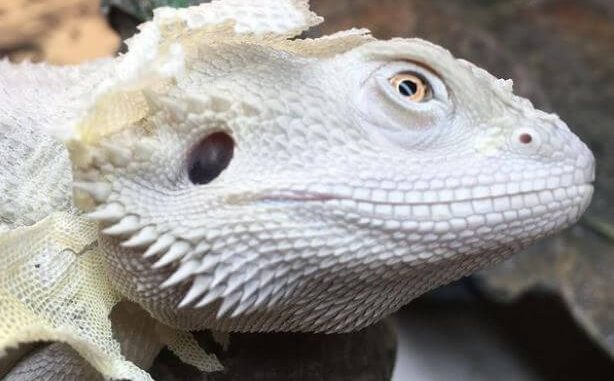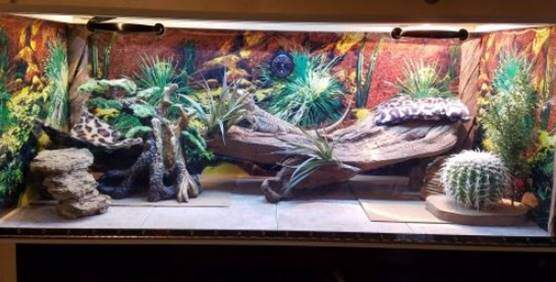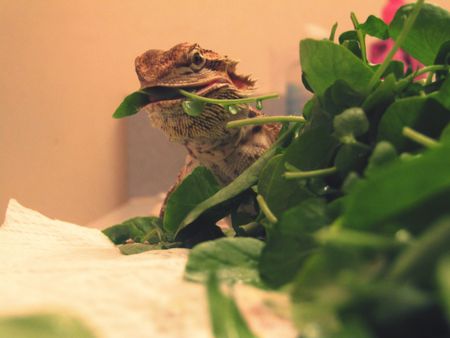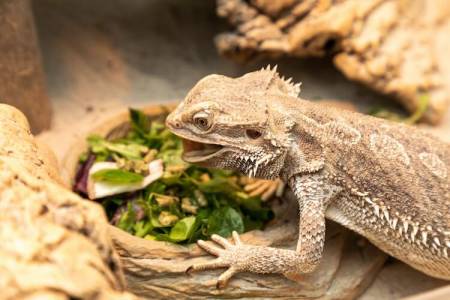Connect with a verified veterinarian in minutes. Licensed vets are available 24/7 to answer your questions. No need to worry about your furry family member.
Has your bearded dragon turned white? Is he showing any other signs or symptoms? If so, then you’ve come to the right place.
In this article, we’ll take a look at several reasons a bearded dragon may turn white and what you need to do. Let’s get started!
What’s Behind a Bearded Dragon Turning White?
Bearded dragons (pogona vitticeps) use their bodies to communicate how they’re feeling, their health, and much more. Their behaviors may be different than a dog’s or cat’s, but as a pet parent, it’s still important to pay attention to your reptile’s behaviors and watch for any changes.
Beardies are able to change the color of their mouth, nose, legs, tail, head, and more.
Bearded dragons may turn their bodies white for several different reasons, which we’ll take a look at in the following sections.
1). Preparing to Shed
One of the most common reasons for white bearded dragons is because they’re getting ready to shed. Shedding is a normal part of their life, especially when dragons are going through fast growth spurts. This is often the case with young and juvenile bearded dragons.
When they become adults, beardies tend to shed about once a year. When your beardie is preparing to shed, you may notice the patches on their top skin begin to turn white. This is a normal process, which can last between 2-3 weeks.
If your beardie is shedding, he’ll feel better if the humidity in his terrarium is between 30% to 40%. It also helps to mist your beardie once a day. If you notice some old skin hanging from him, it’s OK to give your pet lizard a lukewarm bath. However, never help remove the skin. Let him take care of that—he’s an expert—and you don’t want to accidentally hurt him.
2). Temperature Too Hot
When bearded dragons become too hot, they will sometimes turn white (or black). When they are too cold, they usually become a darker color to absorb more heat. However, if they become too warm, they may turn white to absorb less heat. So, if your beardie’s turning white, be sure to check the temperature in his tank.
Bearded dragons need to be kept warm in order to digest their food. Adults require a warm basking area of about 100°F and a cooler spot between 80-85°F. Younger dragons need it warmer, so you may want to check with the breeder or the vet for their preferred temperatures.
3). Turning White When Sleeping
This is another normal behavior of the bearded dragon. They may turn white while sleeping! This has to do with the lizard’s circadian rhythm.
If tank temperatures are too warm at night (above 75°F), beardies may turn to a lighter shade. So, if your beardie’s turning white or a lighter color when he’s sleeping, this is normal behavior.
4). What if My Bearded Dragon is White and Not Eating?
If a beardie is turning white and not eating, this could be a sign he’s not doing well. If he’s also lethargic, then turning white color could be an indication that he’s dying.
In addition, you can check your bearded dragon’s beard. A dying bearded dragon’s beard may be black, but his tail, legs, and face may be pale or white. This can be caused by an obstruction in the bowel, parasites, or old age.
If your bearded dragon all of a sudden changes color, this can be a symptom of an impaction (bowel obstruction). This can be caused by eating large objects, indigestible insect parts, or even from eating the substrate. You’ll need to take your lizard to the vet if you believe this is an impaction.
5). Bearded Dragon Tongue Turning White
Bearded dragons usually have a pink or white tongue that’s a little sticky on the end. This helps dragons grab their prey. While the pale tip of the tongue is normal, it’s not normal for the dragon’s entire mouth to become white or pale. This is an indication of a problem.
A white throat and tongue indicate your dragon may be ill. This can be caused by parasites, anemia, or other health issues. If you’ve noticed these symptoms in your dragon, then it’s time to take him to the vet for a checkup.
6). Bearded Dragon Head & Tail Turning White
Bearded dragons, as mentioned earlier, do shed their skin. Just before this happens, they turn white. However, unlike other lizards, beardies do not shed their skin as a whole piece. Instead, they shed in parts, one at a time.
If your bearded dragon’s head and tail have turned white, it could be that he’s about to shed. It can take beardies a while to shed. This is often the case with young bearded dragons. The older they get, however, the faster the process goes.
7). Bearded Dragon Body Turning White & Not Eating
There are times, as mentioned above when a bearded dragon will normally turn white. However, if his entire body turns white and he’s not eating, this is an indication that somethings wrong.
Your beardie may be indicating that he’s ill or dying, especially if he’s showing some other symptoms or somehow isn’t acting like normal.
You may notice that his feces are runny and smell bad, that he’s lethargic, has lost weight, has cloudy or filmy eyes, and more.
These are signs that are best evaluated by your vet. If your beardie is sick, the vet may be able to successfully treat the problem.
8). Signs a Bearded Dragon is Dying
You may notice these signs and symptoms if your bearded dragon is dying:
- Lethargy
- Cloudy/filmy eyes
- Soft, runny, smell feces
- Swollen tail/limbs
- Not eating
- Gasping for air
- Discolored mouth (white or black)
- Weight loss
- Discolored stomach
- Sunken eyes
- Blood, damaged snout
Again, we have to say that any time you’re worried about your bearded dragon’s health and coloring, then it’s best to contact your vet.
While there are some normal instances when a bearded dragon will turn white (shedding, etc.), they may also turn white when they’re ill. This is the time a vet must be seen. They may be able to successfully treat the health issue. Then you and your beardie can enjoy more years together!
Bearded Dragon Care Guides
Bearded dragons are among the most popular pet reptiles, and they have many fans who treat them as their children. These lizards are gentle and they are quite easy to care for. The bearded dragon is one of the easiest reptile pets to maintain, but this does not mean that it can be taken lightly. The pet owner must understand what he or she is getting into when he or she decides to get a bearded dragon as a pet.
Basking
Bearded dragons bask in the sun to warm up. They will do this for a few minutes in the morning and a few minutes at night. This is what they need to be healthy and their body temperature should be at an optimal level.
The basking spot must be a place that is out of direct sunlight and not in the direct sunlight. A heated terrarium is an ideal spot for this. The terrarium should have plenty of shade provided by a thick cover or tree branches to provide protection from heat, humidity, and direct sunlight. The terrarium should have a secure top to prevent escape attempts by the bearded dragon.
Females will often use a heat lamp to warm up when they are ready to lay eggs. Bearded dragons that are males should not be allowed to bask under a heat lamp. The heat lamp can cause damage to the bearded dragon’s skin and it can cause them to develop sunburn.
Feeding
In the wild, they feed on a variety of insects, plants, and even small mammals. Calcium is important for bearded dragons. This is because they will shed their skin if they do not have enough calcium in their diet. This is one of the reasons why it is so important to provide them with a healthy diet.
When you are deciding what your bearded dragon will eat, it is important to choose foods that have the right amount of nutrients. You can do this by reading the nutritional content on the package. You should also make sure that the foods you feed your bearded dragon are safe for them to eat. This is because they are prone to develop health problems if they eat foods that are not safe for them to eat.

Review symptoms, medications & behavior to keep your pets healthy with a Vet Online in just minutes.
Ask a Vet Live NowTaking Care of Baby Bearded Dragons
Baby bearded dragons should be handled with care. You should handle them when they are small because they can bite and scratch you. They will grow quickly, and this means that they can bite you when they are bigger.
Bearded dragons make great pets, but they can be aggressive and they can also be quite strong. When you are taking care of baby bearded dragons, it is important to make sure that you do not allow them to bite or scratch you. If you need to clean their enclosure, make sure that you do it in a safe way.
Bearded Dragon Morphs
There are many types of bearded dragon morphs. Bearded dragons come in many different colors, and many of them are so beautiful that you will want to take a photo of them. It is important to understand the characteristics of your bearded dragon before you start looking for a different morph.
Leatherback Morph
Leatherback Morph is a skin mutation that occurs when a beardie has not been exposed to UV light. The most common form of this mutation is on the ventral (belly) side of the beardie. The best way to identify a leatherback morph is to look at the belly area and compare it to a normal bearded dragon. A normal bearded dragon has scales that are clear, while a leatherback morph has darker, raised scales. The color of the scales is a mixture of brown and black. A leatherback morph is usually seen in captive bred bearded dragons.
Albino Bearded Dragon Morph
Albino bearded dragons are those that have a lack of pigment in their skin. It is very rare to see an albino bearded dragon in the wild, but they are common in captivity. Albino bearded dragons do not have a dark belly like leatherback morphs. They have light colored scales that may or may not be covered in small dots.
Paradox Bearded Dragon Morph
Paradox morph bearded dragons are those that have a white beard and white belly. These bearded dragons are a rare type of albino. They are not albinos, but they do have a lack of pigment in their skin. Some orange color may be seen on the face of the bearded dragon.
Witblits Bearded Dragon Morph
Witblits are a bearded dragon morph that has a yellow or white beard. The plain bearded dragon has a yellow beard and a light colored belly.
Connect with a verified veterinarian in minutes. Licensed vets are available 24/7 to answer your questions. No need to worry about your furry family member.

Julie
Julie is a graduate of the University of North Carolina, Wilmington, where she studied Animal science. Though contrary to the opinion of her parents she was meant to study pharmacy, but she was in love with animals especially cats. Julie currently works in an animal research institute (NGO) in California and loves spending quality time with her little cat. She has the passion for making research about animals, how they survive, their way of life among others and publishes it. Julie is also happily married with two kids.
Review symptoms, medications & behavior to keep your pets healthy with a Vet Online in just minutes.
Ask a Vet Live Now




